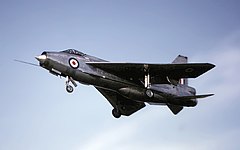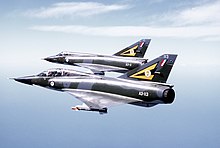Indonesian Space Force Command
Komando Untuk Keamanan Luar Angkasa
Dari Angkatan Antariksa Indonesia
"Kami Menjelajahi Alam Raya untuk Menemukan Keagungan Sang Maha Kuasa"
~Gen. Arip Nurahman~
(Komando Pasukan Khusus Angkatan Antariksa Indonesia)
(Korps Pasukan Khas Angkatan Udara)
Jet-powered fighters
It has become common in the aviation community to classify jet fighters by "generations" for historical purposes. There
are no official definitions of these generations; rather, they
represent the notion that there are stages in the development of fighter
design approaches, performance capabilities, and technological
evolution.
The
timeframes associated with each generation are inexact and are only
indicative of the period during which their design philosophies and
technology employment enjoyed a prevailing influence on fighter design
and development. These timeframes also encompass the peak period of
service entry for such aircraft.
Second generation jet fighters (mid-1950s to early 1960s)
The
development of second-generation fighters was shaped by technological
breakthroughs, lessons learned from the aerial battles of the Korean War, and a focus on conducting operations in a nuclear warfare environment. Technological advances in aerodynamics, propulsion and aerospace building materials (primarily aluminium alloys) permitted designers to experiment with aeronautical innovations, such as swept wings, delta wings, and area-ruled
fuselages. Widespread use of afterburning turbojet engines made these
the first production aircraft to break the sound barrier, and the
ability to sustain supersonic speeds in level flight became a common
capability amongst fighters of this generation.
Fighter
designs also took advantage of new electronics technologies that made
effective radars small enough to be carried aboard smaller aircraft.
Onboard radars permitted detection of enemy aircraft beyond visual
range, thereby improving the handoff of targets by longer-ranged
ground-based warning and tracking radars. Similarly, advances in guided
missile development allowed air-to-air missiles to begin supplementing
the gun as the primary offensive weapon for the first time in fighter
history. During this period, passive-homing infrared-guided (IR) missiles became commonplace, but early IR missile sensors had poor sensitivity and a very narrow field of view (typically no more than 30°), which limited their effective use to only close-range, tail-chase engagements.
Radar-guided (RF) missiles were introduced as well, but early examples proved unreliable. These semi-active radar homing (SARH) missiles could track and intercept an enemy aircraft "painted" by the launching aircraft's onboard radar. Medium- and long-range RF air-to-air missiles promised to open up a new dimension of "beyond-visual-range" (BVR) combat, and much effort was placed in further development of this technology.
Radar-guided (RF) missiles were introduced as well, but early examples proved unreliable. These semi-active radar homing (SARH) missiles could track and intercept an enemy aircraft "painted" by the launching aircraft's onboard radar. Medium- and long-range RF air-to-air missiles promised to open up a new dimension of "beyond-visual-range" (BVR) combat, and much effort was placed in further development of this technology.
The
prospect of a potential third world war featuring large mechanized
armies and nuclear weapon strikes led to a degree of specialization
along two design approaches: interceptors (like the English Electric Lightning and Mikoyan-Gurevich MiG-21F) and fighter-bombers (such as the Republic F-105 Thunderchief and the Sukhoi Su-7).
Dogfighting, per se, was de-emphasized in both cases. The interceptor
was an outgrowth of the vision that guided missiles would completely
replace guns and combat would take place at beyond visual ranges. As a
result, interceptors were designed with a large missile payload and a
powerful radar, sacrificing agility in favor of high speed, altitude
ceiling and rate of climb.
With a primary air defense role, emphasis was placed on the ability to intercept strategic bombers flying at high altitudes. Specialized point-defense interceptors often had limited range and little, if any, ground-attack capabilities. Fighter-bombers could swing between air superiority and ground-attack roles, and were often designed for a high-speed, low-altitude dash to deliver their ordnance. Television- and IR-guided air-to-surface missiles were introduced to augment traditional gravity bombs, and some were also equipped to deliver a nuclear bomb.
With a primary air defense role, emphasis was placed on the ability to intercept strategic bombers flying at high altitudes. Specialized point-defense interceptors often had limited range and little, if any, ground-attack capabilities. Fighter-bombers could swing between air superiority and ground-attack roles, and were often designed for a high-speed, low-altitude dash to deliver their ordnance. Television- and IR-guided air-to-surface missiles were introduced to augment traditional gravity bombs, and some were also equipped to deliver a nuclear bomb.
- See also: List of second generation jet fighters
Powered By:
Tentara Nasional Indonesia Angkatan Darat (Indonesian Army)
Tentara Nasional Indonesia Angkatan Laut (Indonesian Navy)
Tentara Nasional Indonesia Angkatan Udara (Indonesian Air Force)
Sumber: Wikipedia





































No comments:
Post a Comment